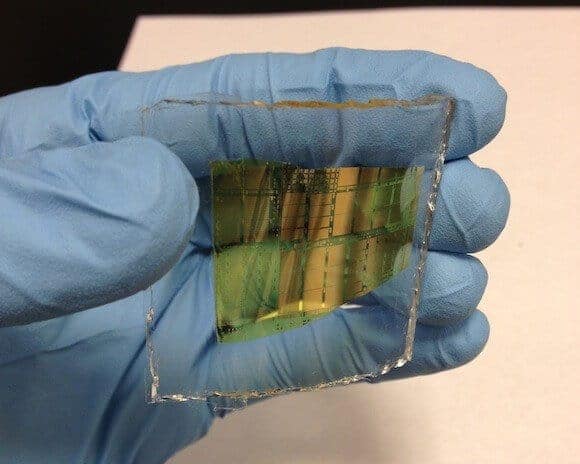When it comes to electronics, silicon will now have to share the spotlight. In a paper recently published in Nature Communications, researchers from the USC Viterbi School of Engineering describe how they have overcome a major issue in carbon nanotube technology by developing a flexible, energy-efficient hybrid circuit combining carbon nanotube thin film transistors with other thin film transistors. This hybrid could take the place of silicon as the traditional transistor material used in electronic chips, since carbon nanotubes are more transparent, flexible, and can be processed at a lower cost.
Electrical engineering professor Dr. Chongwu Zhou and USC Viterbi graduate students Haitian Chen, Yu Cao, and Jialu Zhang developed this energy-efficient circuit by integrating carbon nanotube (CNT) thin film transistors (TFT) with thin film transistors comprised of indium, gallium and zinc oxide (IGZO).
“I came up with this concept in January 2013,” said Dr. Chongwu Zhou, professor in USC Viterbi’s Ming Hsieh Department of Electrical Engineering. “Before then, we were working hard to try to turn carbon nanotubes into n-type transistors and then one day, the idea came to me. Instead of working so hard to force nanotubes to do something that they are not good for, why don’t we just find another material which would be ideal for n-type transistors—in this case, IGZO—so we can achieve complementary circuits?”
Carbon nanotubes are so small that they can only be viewed through a scanning electron microscope. This hybridization of carbon nanotube thin films and IGZO thin films was achieved by combining their types, p-type and n-type, respectively, to create circuits that can operate complimentarily, reducing power loss and increasing efficiency. The inclusion of IGZO thin film transistors was necessary to provide power efficiency to increase battery life. If only carbon nanotubes had been used, then the circuits would not be power-efficient. By combining the two materials, their strengths have been joined and their weaknesses hidden.
Zhou likened the coupling of carbon nanotube TFTs and IGZO TFTs to the Chinese philosophy of yin and yang.
“It’s like a perfect marriage,” said Zhou. “We are very excited about this idea of hybrid integration and we believe there is a lot of potential for it.”
The potential applications for this kind of integrated circuitry are numerous, including Organic Light Emitting Diodes (OLEDs), digital circuits, radio frequency identification (RFID) tags, sensors, wearable electronics, and flash memory devices. Even heads-up displays on vehicle dashboards could soon be a reality.
The new technology also has major medical implications. Currently, memory used in computers and phones is made with silicon substrates, the surface on which memory chips are built. To obtain medical information from a patient such as heart rate or brainwave data, stiff electrode objects are placed on several fixed locations on the patient’s body. With this new hybridized circuit, however, electrodes could be placed all over the patient’s body with just a single large but flexible object.
With this development, Zhou and his team have circumvented the difficulty of creating n-type carbon nanotube TFTs and p-type IGZO TFTs by creating a hybrid integration of p-type carbon nanotube TFTs and n-type IGZO TFTs and demonstrating a large-scale integration of circuits. As a proof of concept, they achieved a scale ring oscillator consisting of over 1,000 transistors. Up to this point, all carbon nanotube-based transistors had a maximum number of 200 transistors.
“We believe this is a technological breakthrough, as no one has done this before,” said Haitian Chen, research assistant and electrical engineering PhD student at USC Viterbi. “This gives us further proof that we can make larger integrations so we can make more complicated circuits for computers and circuits.”
The next step for Zhou and his team will be to build more complicated circuits using a CNT and IGZO hybrid that achieves more complicated functions and computations, as well as to build circuits on flexible substrates.
“The possibilities are endless, as digital circuits can be used in any electronics,” Chen said. “One day we’ll be able to print these circuits as easily as newspapers.”
Zhou and Chen believe that carbon nanotube technology, including this new CNT-IGZO hybrid, will be commercialized in the next 5-10 years.
“I believe that this is just the beginning of creating hybrid integrated solutions,” said Zhou. “We will see a lot of interesting work coming up.”
If our reporting has informed or inspired you, please consider making a donation. Every contribution, no matter the size, empowers us to continue delivering accurate, engaging, and trustworthy science and medical news. Independent journalism requires time, effort, and resources—your support ensures we can keep uncovering the stories that matter most to you.
Join us in making knowledge accessible and impactful. Thank you for standing with us!

